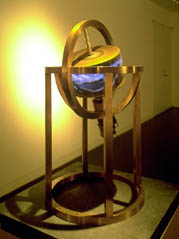
|
| Technical Details: dimensions:
height 875 mm, diameter: 492 mm, industrial bronze, motor-drive,
monitor |
|
We make use of the phenomenon of time to verify reality and to calibrate our position therein. To get a grip on our lives and to be able to determine our place in the flow of events, we perceive time, on the one hand, as an organizing and objective factor, and as a subjective, dynamic, experience on the other. However, the technology of the moving image, which made its entry in this century, also shows time and the perception of time as factors that can be manipulated.
The success of film, for example, is mainly due to the suggestion of continuity between the moving images. This seemingly 'fluent course' makes it possible to conjure up a realistic story happening in time, in which the viewer can lose himself completely. At the same time, the technology enabling this is, as much as possible, kept hidden from the viewer, so that the effect, the optical illusion, remains intact.
However, with his stroboscopic video installation Time/Piece, Boris Gerrets is precisely trying to reveal the discontinuity within a divergent supply of images. A discontinuity which is perhaps much more realistic even: indeed, the 'interweaving of various spaces and realities' also happens in real life, in which reality is never unambiguous, but is always complex and versatile. Time/Piece is a monumental anthology of the phenomenon of time; a reflection on the various orders of time and time experiences which determine our perception of reality and of images.
The work features a video monitor rotating around a vertical axis, in a bronze construction which brings back to us the stands in which globes or sundials were once placed, objects on the basis of which scientists began to connect astronomy and cartography of the world. There is an inscription on the construction: "Time is the mobile image of immobile eternity", a statement with far-reaching philosophical implications from St. Augustine, the fourth-century Church Father.
As soon as you approach the sculpture, the monitor begins to turn in its bronze holder. The quick rotations of the monitor, spinning on its axis like a globe, create a stroboscopic image, which is difficult to interpret at first and in which no linear story can be discovered. When you move around Time/Piece in an attempt to understand what you see, an image gradually unfolds over the full 360 degrees of its circular course. On the monitor you can now see a series of city panoramas, with pedestrians and vehicles moving in a strange, unrealistic fashion, as if these were images from the past, or from a different time order.
In Time/Piece, the interaction between contradictory movements and different realities creates a new area of experience, formed by the movement within the image, that of the monitor itself, the movements and position of the viewer, and the relationship with the comprehensive astronomical movement in which both work of art and viewer are involved. Depending on your position with regard to Time/Piece, you will constantly discover a different story in the images. Just as reality keeps on presenting itself to you in a different configuration and with a different meaning, depending on how you are facing it or how you are looking at it.
Jorinde Seijdel
|
|
